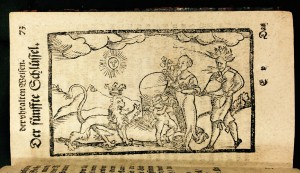Basil Valentine – No Relation
Among the strengths of the Duveen Alchemy and Chemistry Collection are numerous works attributed to one Basil Valentine (Basilius Valentinus), nearly as mysterious an author as he was productive – and no relation to Valentine’s Day, it would appear. The Duveen Collection contains three separately published editions of writings by “Valentinus” about the great stone of the ancients (1626, 1645, 1666), among other titles.
The earliest of these (call number: Duveen D 125), published in 1626, in Leipzig it is thought, contains woodcuts full of symbolism, described as keys, and numbered 1 through 12.

The eighth caught my attention because of its triangles – our current exhibit explores triangles, squares, and circles – but also because of the archers in the upper left and right corners.
A rather fainter bow and arrow is wielded by a blindfolded cherub in the woodcut for the fifth Schlüssel (key) in this edition.
In the edition published in Strassburg in 1666 (call number: Duveen D 128), the illustrations are copperplate engravings, as advertised on the title page.

In the fifth key, the cherub, now with eyes wide open, appears to have pierced the heart held by the central figure.
In the eighth key, the target for the two archers in is a square, not a triangle.
As the above illustrations make clear, our copy of the edition of 1666 also contains copious manuscript annotations through page 73, and only a very few marginal symbols thereafter.
The middle edition of 1645, also published in Strassburg, is a separately paginated treatise, bound with another title (call number: Duveen D 126), and contains the same engravings as in the edition of 1666.
About Basil Valentine
The late Allen Debus, noted historian of science and medicine, wrote of Valentine in the Dictionary of scientific biography, 13 (Charles Scribner’s Sons, held by the Libraries in print and online form): “Supposedly a German Benedictine monk born at Mainz in 1394, Basil Valentine is said to have been a member of St. Peter’s in Erfurt in 1413 and to have been elected prior of the same monastery the following year. Other accounts mention that he traveled widely in Europe and that he made a journey to Egypt late in life. There is no contemporary evidence for any of the facts relating to Basil Valentine and, indeed, the works attributed to him refer to events that occurred after his death (for example, the discovery of America). Although a number of different individuals have been suggested, the authorship of these texts is most commonly attributed to Johann Thölde, a councillor and salt boiler of Frankenhausen in Thuringia, whose Haligraphia (1603 and 1612) closely resembles the Letztes Testament (1626), one of the principal works ascribed to Basil Valentine.” (We have German versions of the Letztes Testament dated 1645 and 1740, plus English translations of 1670 and 1671.)
More recent scholarship about Valentine (and Thölde) includes Gerhard Görmar, “Johann Thölde, Herausgeber der Schriften des “Basilius Valentinus” und Verfasser der Haliographia — eine biographische Skizze,” in Mitteilungen der Gesellschaft Deutscher Chemiker, Fachgruppe Geschichte der Chemie, 16 (2002), 3–19, and the entry by Priesner for “Basilius Valentinus” in Claus Priesner and Karin Figala, Alchemie: Lexikon einer Hermetischen Wissenschaft (Munich: Beck, 1998), the latter available in the Special Collections reference collection (call number: QD23.5 A43 1998).
— R. Rider



